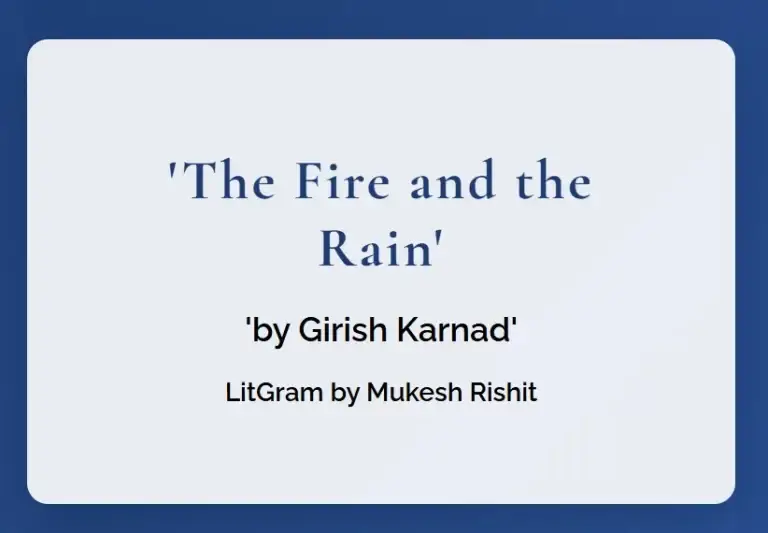Indian literature’s strength often lies in its ability to intertwine ancient myths with modern questions about the human experience. Girish Karnad’s play, The Fire and the Rain, is a glittering example of this. Adapted from an episode in the Mahabharata, this play is a powerful exploration of desire, jealousy, betrayal, and redemption. It plunges into the depths of human emotions while questioning moral complexities and the ultimate role of the divine in shaping human fate.
Table of Contents
Introduction to Girish Karnad and Indian Playwriting
Girish Karnad, one of India’s most celebrated playwrights, had a knack for taking mythological stories and turning them into socially and politically charged narratives. His works, including Hayavadana and Tughlaq, have shaped the landscape of modern Indian drama. In The Fire and the Rain, Karnad adapts a tale from the Mahabharata, but instead of simply retelling it, he uses it to delve into human emotions with startling clarity.
Karnad’s works hold up a mirror to society, and through The Fire and the Rain, he reflects on the destructive nature of human desires. At its heart, the play asks: Can human beings transcend greed, ambition, and jealousy to find redemption?
Overview of The Fire and the Rain
The story revolves around a devastating drought, a long-standing ritual to bring rain, and the lives of those caught up in personal rivalries and emotional chaos. While the drought ravages the land, the characters wrestle not just with nature but also with their inner storms.
The play’s main focus is on Paravasu, a chief priest leading a fire ritual meant to appease the gods and bring rain to the land. His younger brother, Arvasu, is an actor who yearns for love and freedom. Other significant characters include Yavakri, a scholar with a thirst for revenge, and Nittilai, a brave tribal woman who offers unconditional love.
The interplay of these characters’ emotions mirrors the larger crisis gripping their world. This combination of myth and raw human conflict makes The Fire and the Rain endlessly fascinating and universal in appeal.
Mythological Basis: The Inspiration from the Mahabharata
The play is based on an anecdote from the Vanaparva (Forest Canto) of the Mahabharata. Tracing myths back to their origins, Karnad reimagines the story, adding dramatic layers to their relationships, personal vengeance, and struggles with morality.
The ritual of fire (yajna) at the center of the play is inspired by Vedic traditions, where offerings are made to the gods to achieve rain and fertility. However, in Karnad’s version, the yajna becomes a battleground for envy, betrayal, and personal agendas.
Setting: A Land Ravaged by Drought
The barren, scorched land in the play forms an apt metaphor for the characters’ lives, devoid of harmony. The drought is not just external; it reflects the emotional emptiness that drives individuals like Yavakri and Paravasu to ruin. The act of appeasing the gods becomes a desperate race to survive—not just for the rain, but for absolution and meaning in their lives.
The Protagonists and Their Conflicts
Paravasu: The Ambitious Priest
Paravasu is the eldest son of an ambitious Brahmin family. Tasked with leading the ritual, he becomes consumed by his responsibilities, pushing aside family, love, and his own morality. His obsession with power mirrors the fire, which consumes everything in its wake.
Arvasu: The Neglected Brother
Arvasu, often overlooked and wronged by his family, symbolizes innocence and selflessness. He is a sensitive artist who dreams of a life beyond caste and duty. Through Arvasu’s story, Karnad critiques caste oppression and celebrates the redemptive power of love.
Nittilai: The Tribal Woman
Nittilai breaks the mold of conventional female characters in Indian drama. She is bold, defiant, and deeply empathetic. Despite her marginalized status as a tribal woman, she stands as the moral compass of the play.
Yavakri: The Vindictive Lover
Yavakri’s life is driven by his search for power through divine knowledge. Egotistical and consumed by jealousy, he serves as a tragic example of knowledge without wisdom.
Themes Explored in the Play
1. Ambition and its Consequences
Paravasu’s relentless ambition destroys everything he holds dear, showing how power can alienate individuals from their humanity.
2. Human Jealousy and Rivalry
The hatred between brothers and lovers presents a compelling examination of human emotion at its rawest.
3. Desire, Temptation, and Betrayal
Yavakri’s tale is an intricate web of betrayals—romantic, familial, and spiritual.
4. Redemption Through Suffering
The characters find their way through destruction, grief, and eventual forgiveness. Suffering, in Karnad’s hands, becomes a precursor to redemption.
Symbolism in the Play
Karnad masterfully employs fire and rain as metaphors in the narrative:
- Fire represents ambition, destruction, and cleansing. It consumes relationships, exposing the frailty of human connections.
- Rain, on the other hand, symbolizes healing, renewal, and divine grace. The rain is almost an answer to the trials of the characters.
The Role of Gender: Women in a Patriarchal Society
Nittilai’s character questions the deeply rooted patriarchy in the Brahminical world of the play. Her courage and agency offer a stark contrast to the restrictions faced by men and women in traditional caste-bound life.
Power Struggles in a Moral Vacuum
At its core, the play depicts a moral vacuum where the characters’ actions are neither good nor evil but deeply human. Their struggles feel timeless, reminding us that ambition and jealousy are challenges every society must confront.
The Play’s Unique Narrative Techniques
Karnad blends elements of traditional and modern theater in The Fire and the Rain. He uses Indian dramatic traditions like the yakshagana but layers it with psychological realism, making the play accessible yet rich with cultural nuance.
How the Central Ritual Defines the Story
The fire ritual (yajna) is more than just a ceremony to bring rain. It becomes a metaphor for purification and confrontation with the divine. Through this ritual and Paravasu’s moral decay, Karnad critiques how religion can become corrupted by human ambition.
Legacy of the Play and Its Modern Relevance
While deeply rooted in Indian mythology, the play touches on issues that resonate with a global audience—climate, social hierarchy, and human frailty. With the rapid degradation of the environment and even today’s social divisions, The Fire and the Rain remains relevant as a powerful commentary on the human condition.
Critical Reception: How Was The Fire and the Rain Received?
When it premiered, the play was widely praised for its masterful exploration of myth and psyche. Critics appreciated its rich symbolism, while audiences were captivated by its compelling characters. It was later adapted into a feature film directed by Girish Karnad himself, bringing it to a larger audience.
Concluding Thoughts: Why Read or Watch This Play?
The Fire and the Rain isn’t just a story. It’s a searing exploration of the human soul—flawed, vulnerable, and striving for redemption. Karnad’s genius lies in his ability to make an ancient tale feel entirely fresh and urgent. Whether you’re drawn to myth, philosophy, or pure drama, this play offers something for everyone.
So, take a moment. Find a copy of Girish Karnad’s The Fire and the Rain, or watch its theatrical adaptation. Let its flames spark questions about who we are and what we truly seek in life.
FAQs:
- What is The Fire and the Rain about? The play explores themes such as human emotions, ambition, jealousy, and redemption, set against the backdrop of a drought and a religious ritual.
- What inspired The Fire and the Rain? The play is based on an episode from the Mahabharata, specifically the Vanaparva.
- Who are the main characters? Key characters include Paravasu (a priest), Arvasu (his younger brother), Nittilai (a tribal woman), and Yavakri (a scholar).
- What is the meaning of fire and rain in the play? Fire symbolizes destruction and ambition, while rain represents healing and divine grace.
- Why is this play still relevant? Its universal themes of human desire, societal constraints, and the search for redemption resonate in any era, making it timeless.


